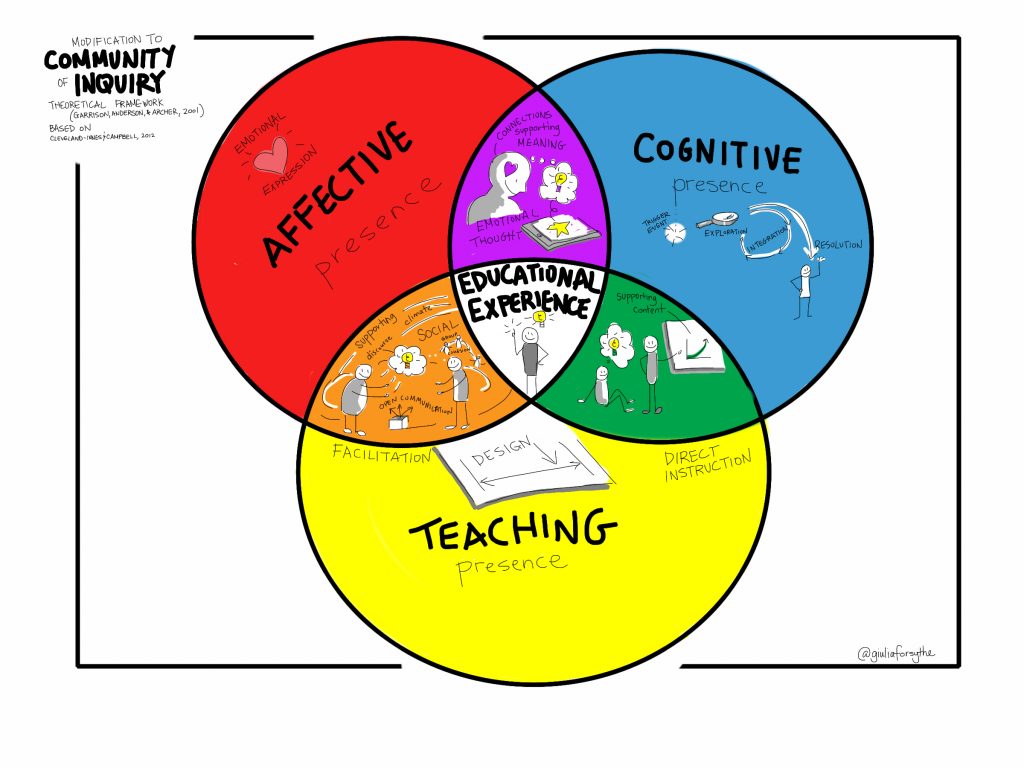Session 1: Community of Inquiry
To do this session
✓ Read the session resources
✓ Review and update your online profile(s)
Session Introduction
Welcome to Adult Education: Introduction to Online and Blended Learning. These resources were originally developed in support of a course offered by Brock University. Structured around 12 Sessions, the materials and learning activities are designed to be practical, hands-on, highly reflective, and iterative.
During the course we build our own community of inquiry based on the COI model. We look at this from multiple perspectives: as a learner, a teacher, and a scholar to improve this experience and our future practices. Most of our work takes place in discussion forums and through reflections. Re-packaged in this open resource, these activities are meant to prompt you to consider how and what you choose to share your learning with your personal learning community.
Bates (2017) describes the skills needed the digital age: communication, autonomy, ethics, teamwork, flexibility, thinking skills, and knowledge management. In organizations from school to society, these skills are essential. This course is designed to develop these skills so it is most useful to you as a learner, an educator, and a professional.
Research on How Learning Works tells us that no matter how well designed a course is, ultimately, in large part, it is the student motivation that will determine success. As Gloobar (2018) cites Ambrose et al, we know that expectancies, value, and the learning environment are important aspects that can often be overlooked. For that reason, the course resources are designed to be flexible to ensure that they are of the most value, and meant to align with your expectations of success.
The culminating task in this course is the creation of an online module.
Brock University has very specific calendar definitions of online and blended:
A fully online asynchronous course is a learning environment that is delivered remotely to individuals with access to the Internet. Although the course may have a set start date and set due dates for assignments, students can otherwise access and participate in the course at times and places of their own choosing. The online component is normally over 80% of the total delivery. A fully online course may include occasional face-to-face meetings, a proctored exam, etc. with the remainder of the content delivered online.
A fully online synchronous course is a conferencing learning environment that is delivered remotely through audio and/or video conferencing to provide simultaneous communications between an instructor at one site and students at other sites on a scheduled day and time. A course is considered to be offered via synchronous conferencing if 80% or more of the content is delivered in this way. A course may have occasional face-to-face meetings, a proctored exam, etc. with the remainder of the content delivered through audio and/or video conferencing.
A blended (hybrid) course is a learning environment where face-to-face teaching time is reduced, but not eliminated, to allow students more time for online study. The online component is normally 50% to 80% of the total course delivery. A blended course may have components delivered via traditional face-to-face; however, at least half of the course delivery is online.
Learning Outcomes
By the end of this session you should be able to:
- articulate the scope of these resources and personal criteria for success;
- connect with your personal learning community; and
- describe the difference between online and blended course offerings and begin to explore why one choice would be preferable to another.
Rationale
Gain familiarity with learning environment tools and get a sense of expectations.
Connection to Theory
Establishing a personal learning environment is part of promoting meaningful learning experiences.
Connection to Practice
Familiarity with the basic tools will allow us to focus on the learning and not let the technical aspects interfere with our progress.
Session Resources
- Bates, A. (2015). The skills needed in a digital age. In Teaching in the Digital Age
- CMU Eberly Center (2014) Learning Principles: Theory and Research-based Principles of Learning. Carnegie Mellon University
- Gooblar, D. (2018) Will My Students Actually Want to do This Assignment? Chronicle of Higher Education.
- Hodges, C., Moore, S., Lockee, B., Trust, T., Bond, A. (2020) The Difference Between Emergency Remote Teaching and Online Learning. EDUCAUSE.
Learning Activities
Tasks
Review your profile pages in the online learning communities you currently participate in (learning management systems, Twitter, etc.). Where appropriate, update the information and upload a photo or picture represents you visually. It does not need to be a typical photo of you. It could be flowers from your garden, your pet, a drawing, or even something abstract. Preferably find an image of you or created by you.
Reflection
This session’s main questions are:
- What are your learning goals?
- What challenges do you anticipate in achieving these goals?
- What online learning experiences have you already had?
- What do you hope you will learn from these resources that will facilitate your personal and professional goals?
- How could these resources be the most useful to you?
Bridge to Next Session
This session explored activities within our learning environment and to start to develop a community of inquiry. Next session we will look at our own levels of comfort with a framework called Visitors and Residents.


